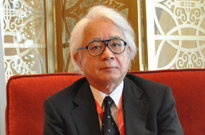当前位置:APALD-亚太肝病诊疗技术联盟年会 » 正文
[APALD访谈]如何应用更新的乙肝管理指南
—— 作者:Masao Omata 时间:2015-09-28 03:05:52 阅读数:
277

Masao Omata教授,日本东京大学胃肠病学系主任、日本山梨县中部和北区医院院长,研究兴趣为肝脏病学、胃肠病学和肿瘤学。在“第七届亚太肝病诊疗技术联盟(APALD)年会”上,作了题为“如何应用更新的乙肝管理指南:亚太肝病研究协会(APASL)和世界卫生组织(WHO)”的专题报告,并于会后就两个指南的异同和临床应用接受了《国际肝病》的专访。
《国际肝病》:2015年公布了APASL 和WHO乙肝诊疗指南,请您简单介绍这两个指南?
Omata教授:WHO乙肝诊疗指南于2015年3月份制定出台,随后亚太地区(APASL)指南出台,相关文章已被《国际肝脏病学》(Hepatology International)杂志接收,将在数周后发表。这些指南旨在预防和治疗肝细胞癌和肝硬化。WHO指南的目的是覆盖全世界每个地区和国家,并被理解和应用;APASL指南则是专门针对亚洲地区,以循证医学为依据。所以虽然二者有一些不同,但目标是一致的。
Prof.Omata: The WHO guidelines came in March 2015, and then our APASL guidelines were made and accepted in the journal Hepatology International. So, it will be published online in a few weeks.These guidelines are for global preventions and treatment of hepacellular carcinoma and cirrhosis strategies. So, I think this targets and is trying to comprehend and cover all the areas of the world. In contrast. APASL is more specific to the Asian areas - and it is evidenced based. So the aims are the same, but there are some differences.
《国际肝病》:这两个指南有何不同?
Omata教授:乙肝诊疗指南包含很多方面,在本届大会上,我仅仅从几个方面介绍了WHO和APASL指南。关于乙肝治疗指征,WHO指南关于乙肝治疗指征较严格,主张观察。与此相比,APASL指南是以循证医学证据为基础,建议更多乙肝患者接受治疗,特别要关注肝纤维化程度。因此,WHO指南是针对所有人,包括无法行乙肝DNA和Fibroscan检查的国家,这是二者最大的不同。
Prof. Omata: I talked today about this issue. The guidelines include so many things, so I will just touch a little bit upon it. In other words, about treatment indications. I judge the WHO guidelines do not include many guidelines for patients to be treated. Rather, it recommends watching the patients. In contrast, the APASL guidelines are based on the evidence available, recommending more patients to be treated, especially by the extent of fibrosis. In other words, this guidelines from the WHO are for everybody, even in countries where HBV DNA detection is not available, or a FibroScan facility. Those areas should also be included in the WHO guidelines. Therefore, those are the differences between the two.
《国际肝病》:对于指南的应用,您认为应该遵循哪个指南?
Omata教授:此次大会是面向专科医生的,他们是给予乙肝患者治疗的人。之前提到,APASL指南针对中国、日本和其他亚洲国家,以循证医学证据为基础,更加严谨。因此,APASL指南应该作为亚洲专科医生日常治疗的指导。而WHO指南除了覆盖亚洲,还包括美国、欧洲和非洲。我认为亚洲肝脏病学家应该应用APASL指南。
Prof. Omata: Well, today’s meeting was for specialists - to educate the people who treat the patients. So, the APASL guidelines are, as I said, meant for the Asian areas such as China, Japan and other countries - and also, it is evidence based. It is more precise. It is more updated. So, these APASL guidelines can be used in daily practice by physicians living in Asia. Whereas, WHO guidelines try to cover not just Asian, but America, Europe, and Africa. So, I think that is a big difference between the guidelines. I belong to APASL - I think it should be used by the hematologists in Asia.
标签:
访谈
乙肝
发表评论
全部评论